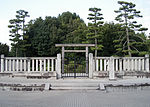

| Emperor Go-Nijō 後二条天皇 | |||||
|---|---|---|---|---|---|
 | |||||
| Emperor of Japan | |||||
| Reign | 2 March 1301 – 10 September 1308 | ||||
| Coronation | 3 May 1301 | ||||
| Predecessor | Go-Fushimi | ||||
| Successor | Hanazono | ||||
| Shōgun | Prince Hisaaki | ||||
| |||||
| Born | 9 March 1285 | ||||
| Died | 10 September 1308(1308-09-10) (aged 23) Heian-kyō, Kamakura shogunate | ||||
| Burial |
Kitashirakawa no Misasagi (北白河陵) (Kyoto)
| ||||
| Spouse |
(m. 1303) | ||||
| Issue | See below | ||||
| |||||
| House | Yamato | ||||
| Father | Emperor Go-Uda | ||||
| Mother | Horikawa (Minamoto) Motoko | ||||
| Religion | State Shinto | ||||
| Signature | |||||
Emperor Go-Nijō (後二条天皇, Go-Nijō-tennō, 9 March 1285 – 10 September 1308) was the 94th emperor of Japan, according to the traditional order of succession. He reigned from 1301 to his death in 1308.[1]
This 14th-century sovereign was named after the 12th-century Emperor Nijō, and go- (後), translates literally as "later"; and thus, he is sometimes called the "Later Emperor Nijō", or, in some older sources, may be identified as『Nijō, the second』or as "Nijo II".
Before his ascension to the Chrysanthemum Throne, his personal name (his imina) was Kuniharu-shinnō (邦治親王).[2]
Go-Nijō was the eldest son of the 91st emperor Emperor Go-Uda. He belonged to the Daikakuji-tō branch of the Imperial Family.
Emperess: Fujiwara no Kinshi (藤原忻子) later Chōrakumon-in (長楽門院), Tokudaiji Kintaka's daughter
Naishi: Fujiwara Tamako (藤原 頊子) later Banshūmon-in (万秋門院; 1268 - 1338), Ichijō Sanetsune’s daughter
Lady-in-waiting: Fujiwara Muneko (藤原 宗子) also Chunagon'no-tenji (中納言典侍), Itsutsuji Munechika’s daughter
Naishi: Koto Naishi, Taira Munetoshi’s daughter
Court Lady: Dainagon-no-tsubone (fujiwara), Sanjo Kinyasu’s daughter
Court Lady: Lady Mikushige (fujiwara), Sanjo Kinchika
Court Lady: Taira Nobusuke’s daughter
Court Lady: Shindainagon-no-Tsubone
Kuniharu-shinnō was made an imperial prince by Imperial proclamation in 1286.
In 1296, he became crown prince (heir) to the Jimyōin-tō Emperor Go-Fushimi, his second cousin.
Go-Nijō's father, the Emperor Go-Uda reigned as cloistered emperor during his reign.
The succession dispute between the Daikakuji and Jimyōin branches of the Imperial Family continued during his reign. His grandfather, the retired Emperor Emperor Kameyama was said to have acted through the Bakufu to ensure Go-Nijō's enthronement.

On 10 September 1308, Go-Nijō died of illness.
Go-Nijō is buried at Kitashirakawa no misasagi (北白河陵) in Sakyō-ku, Kyoto.[4]
Kugyō (公卿) is a collective term for the very few most powerful men attached to the court of the Emperor of Japan in pre-Meiji eras. Even during those years in which the court's actual influence outside the palace walls was minimal, the hierarchic organization persisted.
In general, this elite group included only three to four men at a time. These were hereditary courtiers whose experience and background would have brought them to the pinnacle of a life's career. During Nijō's reign, this apex of the Daijō-kan included:
The years of Go-Nijō's reign are more specifically identified by more than one era nameornengō.[5]

| Regnal titles | ||
|---|---|---|
| Preceded by | Emperor of Japan: Go-Nijō 1301–1308 |
Succeeded by |
|
| |||||||||
|---|---|---|---|---|---|---|---|---|---|
| Legendary |
| ||||||||
| Yamato |
| ||||||||
| Nara |
| ||||||||
| Heian |
| ||||||||
| Kamakura |
| ||||||||
| Northern Court |
| ||||||||
| Muromachi |
| ||||||||
| Azuchi-Momoyama |
| ||||||||
| Edo |
| ||||||||
| Empire of Japan |
| ||||||||
| Japan |
| ||||||||
Unless otherwise noted (as BC), years are in CE / AD * Imperial Consort and Regent Empress Jingū is not traditionally listed. | |||||||||
| International |
|
|---|---|
| National |
|